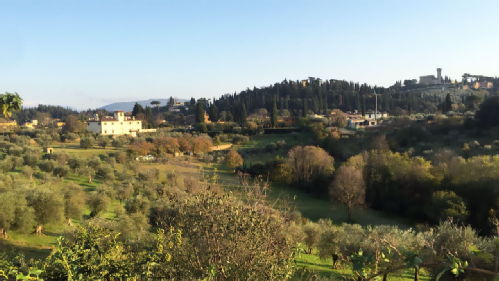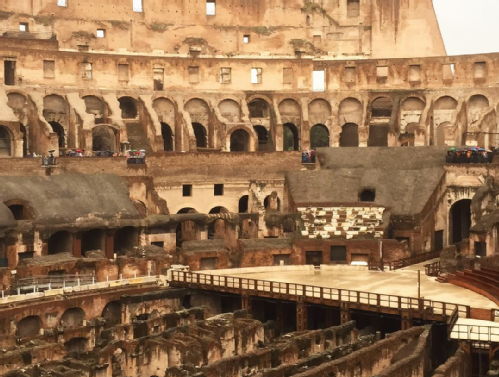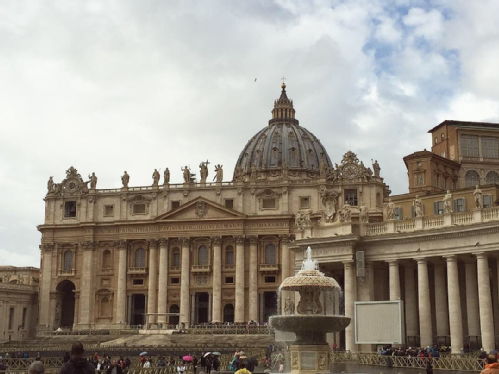All 3 entries tagged Travel
View all 0 entries tagged Travel on Warwick Blogs | View entries tagged Travel at Technorati | There are no images tagged Travel on this blog
December 10, 2018
Arrivederci Venezia!
After an intense ten weeks of studying at Warwick’s Palazzo Pesaro Papafava in Venice, my time living abroad has finally come to an end. I took a moment to reflect upon my overall experience here whilst crossing the serene lagoon, taking the Alilaguna boat for one last time on my way to Marco Polo airport. Studying abroad has undoubtably been a unique opportunity to embark on an in depth exploration of Italian culture. I have practised my language skills daily and have increasingly become familiar with particular colloquial terms. To a large extent, I am confidently leaving Italy with the knowledge that when I eventually return I will have the ability to not only order food in restaurants and buy tickets for museums and transport but also, most importantly, I can enjoy refreshing conversations with the locals and benefit from their perspectives.
During my final week in Venice I decided to ensure that I had visited all of the beautiful churches which are open to the public. There are many spectacularly-decorated Catholic churches to see: one hundred and thirty nine are spread across the nineteen islands in the lagoon. I have been spoilt for choice for opportunities to view exquisitely ornamented façades and impressive paintings such as those by Titian, Tintoretto and even Veronese on display. However, I had left one of the most intriguing examples of architecture for last. The Church of San Giorgio Maggiore is situated on an island which shares its name and can be seen as a key focal point from the walk to St Mark’s Square, opposite the Piazzetta. A formidable example of Renaissance classicism, the San Giorgio Maggiore was designed by the famous Andrea Palladio during the second half of the sixteenth century and was home to Benedictine monks.
I ventured across to the island on a vaporetto boat and was instantly awestruck by the imposing nature of its massive, white marble columns. These columns are in stark contrast to the entrances of Venice’s other churches, such as the gothic red brickwork of Basilica Santi Giovanni e Paolo. Inside the vast church itself there are high stone ceilings and undecorated walls. Two important works by Tintorretto are exhibited here; The Last Supper and The Fall of Manna. The domed ceiling of the basilican nave, leading to the altar, allows for the bright sun to shine within. Visitors are encouraged to climb to the top of the church’s very tall bell tower which provides stunning views of Venice and its surrounding islands, particularly San Giorgio Maggiore’s neighbour - the Giudecca.
As my term drew to an end in early December, Venice began to welcome in the Christmas spirit. Celebrating the lead up to Christmas in Italy was a truly incredible experience because I was able to become acquainted with typically Italian traditions and Christmas foods. The lights and a pretty Christmas tree were put up in St Mark’s Square, making the atmosphere very warm and cheerful. Cafés began to sell the well-loved Italian hot chocolate, which is much more rich and luxurious than that which we drink back at home in the UK. I also took a special trip to Verona, my newly-found favourite city, to see their excellent Christmas market with my friends. Here I was able to sample frittelle (a fried, doughnut-like flat bread) and also panettone. Both of these treats were very delicious and indulgent! I will certainly be purchasing a panettone for my family to enjoy this Christmas.

Overwhelmingly, I have loved my time exploring Venice and much of Northern Italy this academic term. My greatest highlight has been making lasting friendships with the other History students who also chose to take the Renaissance Stream option. We have bonded over our shared moments of homesickness and endured the difficulty of a perilous aqua alta together, still being able to thoroughly enjoy all the beautiful culture which Venice has to offer. I am confident that I have gained some incredible friends with whom I can reminisce and laugh about the countless memories which we've made together these past ten weeks. All that is left to say is, thank you to the Warwick History Department for giving me this wonderful opportunity, I will cherish it forever. Arrivederci Venezia!

November 22, 2018
A Weekend in Florence
At the end of week seven, aware that time is hurtling ever closer towards the final weeks of my term studying Renaissance history in Venice, I took a trip along with two of my course mates to Tuscany. A visit to the famous and culturally-rich city of Florence during my studies in Italy was my top priority, providing a useful site of comparison to Venice in the Renaissance period. With a keen interest in Renaissance art and a firm belief in historians utilising visual sources to contribute to their discussions on cultural and societal trends in sixteenth-century Italy especially, our first activity was to explore the Uffizi galleries.
Located adjacent to the Piazza della Signoria, the Uffizi galleries holds one of the best and largest collections of priceless works of the Italian Renaissance, making it a very busy tourist attraction in Florence. Despite having to wait in a queue for over an hour to gain entry to the galleries, the wait was thoroughly worthwhile. The building complex, originally made to house the Florentine magistrate’s offices, is enormous and spans three floors of precious artworks and sculptures. Although I was in awe of all of the galleries possessions, my personal highlights include seeing many masterpieces which I have come across in my studies previously. The incredible opportunity to view Sandro Botticelli’s Primavera and The Birth of Venus is one which I will never forget. I will cherish the experience of seeing Leonardo da Vinci’s Annunciation and Titian’s Venus of Urbino firsthand, also benefiting greatly in the collection of my dissertation research on the historical debate of the rise of the individual by accessing important portraits such as those by Piero della Francesca.
Exploring the historical centre of Florence, I was immediately struck by the difference in architecture of the Strozzi and Medici palaces when juxtaposed with the Venetian palazzos on the Grand Canal which I walk past most days. The colossal rusticated stone bricks of the Strozzi palace give the building a fortified appearance and a sense of the great power wielded by the noble family. Commissioned by Fillippo Strozzi the Elder in 1489, in competition with the other prominent banking family of Medici, It’s imposing brickwork and huge, strong walls mirrored the design of Florence’s well-known, previous medieval and renaissance government building, the Signoria.
We also visited the beautiful Palazzo Medici Riccardi and witnessed in it’s chapel the impressive fresco of the Cavalcade of the Magi by Benozzo Gozzoli. In a move away from the medieval gothic style, the gardens and courtyards of the palace hold grand sculptures created in keeping with the popularity of Roman classicism flourishing within the art history of the Renaissance. In a surprisingly unexpected turn, the Palazzo Medici Riccardi is currently holding a temporary exhibition on the street artist Banksy, a modern artist who also fascinates me. The exhibition entitled This is Not a Photo Opportunity featured twenty of his highly controversial works, exploring political themes and criticism of our present capitalist society.
Despite the chill of winter winds, we ventured over the Arno River crossing the busy Ponte Vecchio, lined with expensive jewellery shops. Due to the time constraints of our weekend trip, we were unable to actually go inside the Pitti Palace but did highly enjoy wandering around the expansive park, the Boboli Gardens. They were created for the wife of Cosimo I de’Medici, Eleonora di Toledo, during the sixteenth century and were very beautiful and peaceful. Climbing to the top of Boboli Hill whilst the sun was setting, we were astounded by the picturesque view of the Tuscan country side with it’s quaint olive groves.
I would highly recommend a visit to this beautiful city. I warmly anticipate my return in the future, aiming to stay for a longer period to more fully appreciate its historic splendour and the many outstanding places of interest available to explore in Florence.

November 10, 2018
My Travel Week: Visiting Rome and Verona.
After an intense but fascinating first five weeks studying in Venice, in week six of the academic year we were encouraged by our tutors to explore more of Italy. Venturing out of Venice and the comforting environment of Warwick’s Palazzo Pesaro Papafava, which we have now become acclimatised to, students were given the unique chance to sample the culture of different regions within Italy.
I had been looking forward to travel week since I first decided to undertake the Renaissance Stream option for my history degree in first year. The scheme gives students the brilliant opportunity to gather primary source material from museums, galleries and the architecture of churches and important landmarks which then can be utilised within our Venice in the Renaissance essays and ultimately even our dissertation, should it be based around a relevant topic. Furthermore, I was also excited by the prospect of exploring the history of Italian cities with my friends and experiencing new adventures together.

My friends and I first visited the ‘eternal city’: Rome. Known for its classical and ancient monuments, our itinerary in Rome was based around an essential tour of the Colosseum. Built east of the Roman Forum in AD 80, the Colosseum noticeably attracts many tourists from all over the world. I found that despite the business and a long time spent queuing for entry outside in the rain, it was a rewarding visit as I witnessed an iconic symbol of Imperial Rome. We also enjoyed ascending the famous Spanish Steps up to the Trinità dei Monti church and the Villa Medici, situated on Pincio hill. We were fascinated by the history of the Medici residence in Rome, benefiting from a fantastic guided tour of the Villa and its gardens. Rome’s other must-see attractions were of course the Vatican and its spiritual centre, St. Peter’s Basilica. A personal high point in my historical studies was visiting the Pinacoteca art gallery in the Vatican museums and having access to masterpieces such as Caravaggio’s Entombment and Raphael’s Oddi Altarpiece.
During the second part of the week, I traveled to Verona with two different friends. Immediately we were struck by the beauty of historic city centre, featuring a grand square with a fountain and an impressive Roman amphitheatre built around the end of the I century B.C. The ancient Arena di Verona is still in use today however it runs performances less regularly during the winter months. Despite not being able to watch a show there, we climbed to the top of the forty-four steps of the amphitheatre and felt a sense of it’s vast architectural scale. Afterwards, we wandered down quaint cobbled streets lined with expensive shops and patisseries and visited the incredibly peaceful cathedral in Piazza Duomo, which was filled with important medieval and renaissance frescos and artefacts. Climbing the tall Torre dei Lamberti, built in 1172 by the powerful Lamberti family, was also a highlight of my stay. At the top of the 368 steps there is a picturesque view of the entire city and the medieval Castelvecchio which bridges the river Adige below.
Travel week was a fulfilling experience which not only gave us a better insight into the history of the Italian Renaissance but also encouraged us to learn new practical skills as we organised our own trips and found our way in big cities. At first this was rather daunting and culminated in us getting lost multiple times but the initial worries quickly dissipated and the experience was it was entirely worthwhile. Travel week has given me many wonderful memories of beautiful Italy to treasure and has strengthened my friendships. I would highly recommend taking the Renaissance Stream and spending a week journeying across Italy to all History first years at Warwick!
 Samantha Haynes
Samantha Haynes

 Please wait - comments are loading
Please wait - comments are loading
 Loading…
Loading…

